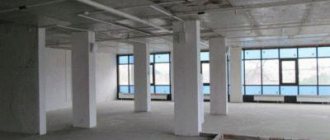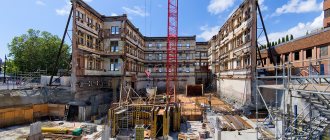No matter how complex and serious the issue of converting residential premises to non-residential may seem, everything is much simpler than it seems.
In this article I will write briefly and in human language about:
- how to convert non-residential premises into residential ones;
- about what residential and non-residential premises are;
- what conditions are needed to change the status of the premises;
- why they may refuse to transfer the status of real estate;
- what documents you will need;
- how to write a transfer application;
- where to go;
- what is the period for changing status;
- what is the cost of translation;
- what to do when you are approved for the transfer of premises from non-residential to residential.
How to convert non-residential premises into residential ones - video.
The procedure for transferring non-residential premises into residential premises is regulated by the Housing Code of the Russian Federation dated December 29, 2004 N 188-FZ.
To transfer non-residential premises to residential premises, first of all, you need to check whether the conditions for such a transfer are met : the premises should not be encumbered by the rights of third parties and must comply with established requirements.
To transfer non-residential premises to residential premises, the owner of the premises or a person authorized by him (representative) submits to the body carrying out the transfer of premises (hereinafter referred to as the local government body) or through a multifunctional center for the provision of state and municipal services (hereinafter referred to as the multifunctional center):
- application for transfer of premises;
- title documents for the premises being transferred (originals or notarized copies). Such documents must be submitted if the right to the premises is not registered in the Unified State Register of Real Estate (hereinafter referred to as the EGRN);
- a plan of the premises being transferred with its technical description;
- floor plan of the house in which the room being transferred is located;
- reconstruction and (or) redevelopment project, if such measures are necessary to use the premises as residential.
The owner or representative has the right not to submit title documents for the premises, a plan of the transferred premises and a floor plan of the house; in this case, the body carrying out the transfer of premises requests it in the manner of interdepartmental cooperation.
It should be noted that it is not allowed to require the presentation of other documents.
Deadline for making a decision. The decision to transfer or refuse to transfer the premises must be made no later than forty-five days from the date of submission of the application for transfer and no later than three working days from the date the decision is made, issued or sent to the address specified in the application.
If an application for transfer of premises through a multifunctional center is submitted, the decision is sent to the multifunctional center, unless another method of receiving it is indicated by the owner or representative.
If it is necessary to carry out reconstruction and (or) redevelopment of the transferred premises, for use as residential premises, the decision must indicate a requirement for a list of works necessary for their implementation.
Completion of reconstruction work and (or) redevelopment is confirmed by an act of the acceptance committee , and is the basis for using the transferred premises as residential premises.
After transferring the premises from non-residential to residential, you need to enter this information into the Unified State Register of Real Estate. To do this, the local government body must send to the rights registration authority:
- a decision to transfer non-residential premises to residential premises, if redevelopment work is not required;
- act of the acceptance committee, if redevelopment work was carried out.
The rights registration authority must enter information into the Unified State Register within 15 working days from the date of receipt of the documents and notify the owner or representative about this within five working days from the date of entering the information into the Unified State Register.
In addition, through your personal account on the Rosreestr website, you can independently contact Rosreestr from home or office, and thereby save your precious time.
What is non-residential premises
What is non-residential premises
There is no official definition of the concept of “non-residential premises” in Russian legislation. Therefore, it has to be determined by several inherent characteristics.
This, for example, is its functionality - as the name suggests, it is not intended for living, but it means that it can be used for other purposes. And state registration - since non-residential premises are real estate, it, say, must have its own address. And just physical characteristics - such as isolation, the presence of material boundaries, the presence of an entrance...
Living space is
According to all these definitions, the concept of non-residential premises includes a whole variety of different real estate objects - shops and warehouses, factories and restaurants, offices and kindergartens...
Here, I probably need to say something about the apartments. These premises are not residential, but they cannot be considered non-residential either, if only because they are most often intended for someone else’s residence. However, we will not take them into our analysis - if the developer rents out not a residential complex, but a complex of apartments, then, apparently, he has reasons for this and cannot provide housing to clients.
And if the “apartment complex” is a temporary measure, then the transfer of premises to residential status is the concern of the developer, and not just his clients, it will be carried out en masse and will not encounter any serious obstacles in the process.
Advantages of the apartments
Apartments, despite their status, continue to be popular, and some buyers specifically choose this particular housing format. Mainly because apartments are cheaper than apartments (other things being equal)
. The cost reduction can reach 20% and is explained by the fact that such housing is not subject to general legislative rules that relate to housing parameters, as well as the organization of the local area.
Such residential complexes have many useful services - you don’t have to go far for household services. Often such houses offer cleaning, grocery delivery, and a laundry service; in addition, such projects, as a rule, are built in convenient areas with high-quality and established social infrastructure.
What is residential premises
Living space is
It’s easier to define residential premises – these are residential buildings and their parts, as well as apartments, rooms and their parts. However, in order to obtain residential status, they must also meet a number of certain requirements. This includes the location in a residential area - where there is at least sewerage, running water and electricity. And good insolation. And compliance with all safety requirements. In general, a lot of things.
Sometimes a separate building can be transferred from non-residential premises to residential premises, but we will not touch on this topic and will talk about those premises that are located in apartment buildings. They either initially have all the necessary characteristics, or they can obtain them - for example, in the process of redevelopment or some kind of work with documents.
Most often, such premises are located on the ground floor and are primarily occupied by infrastructure facilities - a pharmacy, a store, a coffee shop, or whatever. Of course, they can be located in another part of the house - some developers offer their clients spacious cellars on the upper floors of high-rise buildings, and in many Russian cities houses with attics are still popular. And yet, for Moscow and the Moscow region these are exceptions to the rule rather than widespread practice.
Difference between building categories
First of all, let's look at the difference between residential and non-residential real estate from a regulatory point of view. The main difference here lies in the regulatory and operational requirements for certain categories of buildings. Housing must be equipped with a minimum set of utilities necessary for the normal existence of people in it. Such benefits include:
- Electricity supply.
- Running water or access to another source of clean water.
- Heating sources – centralized or individual (stoves, boilers, fireplaces).
- Sewerage or equipped latrines.
- Availability of necessary social infrastructure near the place of residence - shops, clinics, schools and kindergartens.
In addition, an important factor in recognizing a premises as suitable for all-season living is its area and layout. To obtain permission to register a family in the premises, it is necessary to comply with the minimum allowable living area. When converting a private house into residential premises, it is important what category of land it is located on.
Let’s say that if a country house is located outside the city, on agricultural land, then it is impossible to convert it into a residential building. At the same time, country houses located on the territories of gardening cooperatives within municipalities are subject to re-registration in accordance with the law on country house amnesty. After this, in a privatized house, subject to compliance with housing standards - availability of electricity, heating, and so on - you can get a residence permit.
However, the issue of transferring real estate from non-residential to residential is relevant not only for summer residents. In large cities, both in Western countries and in Russia, the trend of converting industrial and administrative buildings into luxury housing has recently become fashionable. Such ex-industrial residential buildings are called “lofts”. In recent years, in Moscow alone, developers have renovated over one and a half dozen industrial and administrative buildings into residential premises.
If desired, the reverse process is also quite possible - transferring a residential apartment or house to non-residential. The most common example is the location of shops, hairdressers and eateries on the ground floors of Soviet-built high-rise buildings. For this purpose, businessmen buy such an apartment on the ground floor, overlooking a crowded street. Then it is re-registered as a non-residential premises, and permission is obtained from the supervisory authorities for the appropriate redevelopment with the installation of a separate entrance.
What is needed to change the status of real estate
Residential building
This means that if you want to turn a non-residential premises you own into a residential one, you need to make sure that it meets a number of conditions.
Perhaps the first and most important of them we have just outlined is that the premises should really belong to you. Owners of premises with a mortgage, premises in collateral, as well as those who share the premises with other owners, may not count on a positive decision.
All sanitary and safety standards must also be observed, including fire safety rules.
Another limitation, closely related to the previous point, is the location of the room - say, if it is located on the ground floor, or in other words, the basement, then it will not be possible to make it residential either. Judge for yourself - what kind of insolation will there be? What about ventilation? And finally, you can’t ignore a whole host of technical characteristics. It will, of course, be boring for ordinary people to go into them, but they still have to do it.
Why do apartments need legal status?
The first apartments appeared in Moscow 11 years ago. Commercial premises in the center were not in demand. Developers had to look for a new format for their use in order to compensate for their costs. The concept was quickly picked up in other cities. On the wave of popularity in Russia, apartments were opened in business centers and entire apartment complexes, for which even old departmental buildings were reconstructed. A new convenient format for living in the city center has appeared. Nearby are theaters, cinemas, restaurants. True, over the years the status of the apartments has not changed. Legally, they remained uninhabited.
The concept of “apartment” is not defined in any current law. Therefore, such real estate is significantly different from apartments. The apartments are not subject to housing legislation. Increased tariffs for electricity and water apply. Owners cannot complain about loud neighbors, and a noisy office can open at any moment behind the wall.
In what cases can you be refused?
Refusal
If the room does not meet the requirements mentioned above, you can try to remodel it - for example, carry out redevelopment, which we will talk about in more detail below. But if the premises, even after the changes, do not have a list of all the necessary characteristics, then you will most likely be refused to transfer it to the status of residential premises.
And it doesn’t even matter what exactly the problem is - in the technology (no electricity, no windows, or simply the layout is not conducive to living) or in the documents (you didn’t find everything you needed - or the information you provided suddenly does not correspond to reality) . Yes, we shouldn’t forget about the bureaucratic part of the process either; it is no less, if not more important, than the technical one. So let's move on to it.
Is it possible to use residential as commercial and vice versa?
Using residential real estate as commercial and vice versa is prohibited by law.
The only possibility of such use can be identified only in the case when an individual entrepreneur is engaged in his professional activities (for example, tutoring or legal practice), but in this case (according to Article 17 of the RF Housing Code) the following conditions must be met:
- The legitimate interests and rights of other residents are not violated.
- Fire safety, sanitary and hygienic requirements, rules for the use of residential premises and other requirements are observed.
- There is no industrial production located.
Why can’t it be used legally and what could be the consequences?
The Civil Code clearly regulates the use of residential real estate in Art. 288 and 671 of the Civil Code of the Russian Federation: residential premises are intended only for residence (the owner, members of his family or, if the apartment is rented, tenants).
Consequences for unlawful (misdirected) use of real estate may be as follows:
- For using residential premises for purposes other than their intended purpose, the fine will be from 1 to 1.5 thousand rubles (Article 7.21 of the Code of Administrative Offenses of the Russian Federation).
- If the owner of a residential premises uses it for other purposes and at the same time systematically violates the interests and rights of neighbors (even after a warning from the local government), then he may lose his right of ownership of the residential premises (Article 293 of the Civil Code of the Russian Federation).
- For violation of the rules for maintaining and transferring residential premises to non-residential premises, a legal entity may be fined in the amount of 40 to 50 thousand rubles (Article 7.22 of the Code of Administrative Offenses of the Russian Federation).
- If people permanently live in non-residential premises, this will be a violation of the sanitary and epidemiological requirements that apply to the operation of premises. This will entail the imposition of an administrative fine:
- for legal entities in the amount of 10 to 20 thousand rubles or suspension of activities for up to 90 days;
- for an individual entrepreneur – from 1 to 2 thousand rubles or administrative suspension of activities for up to 90 days;
- for an individual – from 500 rubles to 1 thousand rubles.
Required documents
Documentation
The list of documents that are necessary for the transfer of non-residential premises to residential premises is defined in the Housing Code. However, if you address your request to a notary, or even directly to the MFC or to the local government body that decides these issues, then they will also probably help you with everything and explain everything
List of documents for transfer from non-residential premises to residential:
- Applicant's passport;
- Any document confirming your ownership rights - for example, an extract from Rosreestr;
- Confirmation of the safety of the premises and its compliance with all necessary standards, received from the relevant services - the Ministry of Emergency Situations, SES, and so on;
- Technical plan of the premises and its cadastral passport;
- Redevelopment project, if it is needed to transfer the premises from one status to another;
- Any additional documents that may help in your case - for example, conclusions from the BTI, floor plan of the house, even just approval from neighbors;
- Finally, an application to transfer the premises from non-residential to residential status.
If the housing parameters correspond to the new status
You need to go to the body that deals with issues of changing status (in the capital this is the City Property Department)
with an application and a set of documents.
The set includes an extract from the Unified State Register of Real Estate (confirming ownership)
, a copy of the passport, and a technical passport of the apartment from the BTI
(confirming compliance with the requirements)
. The latter document may not be provided; in this case, department employees will send the request themselves, but because of this, it may take more time to consider the application. Yes - you still have to pay a fee, the amount is about 20 thousand rubles.
After inspection of the housing by employees of the commission sent by the Department, a decision will be made to change the status of housing
or refusal
with a clear justification of the reasons.
If the reasons include such inconsistencies that can be eliminated by redevelopment, it is worth doing just that (the procedure is described below)
.
How to make an application to change the status of the premises
Sample application for transfer of non-residential premises to residential
The last point deserves special attention. The fact is that it does not have any strictly established form for Russia, so it can vary greatly from region to region.
In order not to make any mistakes, do not write a statement in free form - first, it is better to consult with lawyers or check what standard is established by your local authorities and whether it is established at all.
In the application, in any case, you will need to indicate the address of your premises, enter information about it from Rosreestr, as well as add your personal information to this and at least briefly outline the plan of changes you have planned. If you suddenly forget something, you may be asked to provide additional documents or they may simply find the necessary information on their own - but this is a waste of time, and we do not need it.
Also, special attention should be paid to cases when, during the redevelopment process, you somehow affect common areas - install a new door in the corridor, make changes to the facade, appropriate part of the basement. All this will require additional permits and approvals - in general, papers that should also be provided along with a single package of documents.
Registration of changes in Rosreestr
The final stage is registration of all changes in Rosreestr,
Simultaneously with registration, a decision on the new status of housing is also formalized, which is made by the Department. You can submit an application to Rosreestr in person or send it through the MFC. Specialists will make the necessary changes to existing records, after which the apartments will officially receive the status of residential real estate. There is no additional need to formalize ownership rights; this procedure is performed automatically; the corresponding document is issued to the owner upon completion of all actions within the framework of registration of the new status.
Where to go to change the status of real estate
We are running to change the status of the premises
You need to submit your request and the collected package of documents to the nearest MFC or directly to the local government body that deals with this. This could be either the Housing Fund Administration or some special department. Although in some parts of our country all this can be done even online, simply through the State Services portal, in most regions you will still have to leave your home and visit the relevant authority in person.
Again, if your premises need redevelopment to change the status, then even before collecting all the necessary documentation, you can contact the architects. It may be possible to obtain permission after the necessary repairs, and he will even be able to help with this. You can also expect help from architects and engineers with the necessary documents.
Where to start: the legal side of the issue
The first step is to put the legal side of the issue in order. Namely:
- Obtain ownership of housing if
we are talking about an apartment in a new building and this has not yet been done.
To do this, the new building must be put into operation (this is done by the developer)
, and the apartment must be transferred to the shareholder according to the acceptance certificate.
All that needs to be done in this case is to submit an application to Rosreestr along with some documents (copy of the DDU, passport, acceptance certificate)
and pay a fee
(about 300 rubles)
. You can take the package in person or send it through the MFC.
In fact, developers also offer the service of registering property rights,
however, they ask for an amount of 30 thousand rubles for its provision
(for mysterious reasons, never established by the Novostroev.ru portal, this is much higher than the official fee of 300 rubles)
. This is much more expensive than registering it yourself, so we cannot recommend this method of obtaining title.
- Remove encumbrances. One of these is the mortgage debt to the bank, which must be repaid.
Timing and cost
waiting man
By the way, the period for consideration of your application depends on the region - it can vary from a month to three. A few working days after the decision is made, you will be informed about it, and within another three months you will be able to appeal it if the result is negative.
Afterwards, all that remains is to register the premises with a new status in Rosreestr. But don’t forget to add to this time the time you will spend on all preliminary approvals, drawing up a package of documents and going through the authorities.
You can, for example, take care of utilities in advance, because in non-residential premises they are more expensive than in residential ones, which means you will need to recalculate. Well, and, again, redevelopment - in some cases, the work of repairmen can take even longer than all the bureaucratic delays.
It is not possible to name the exact amount that it will cost you to convert non-residential premises into residential ones, because each case is individual and requires individual consideration. For example, if someone in the room does not need to change anything except documents, then another will have to carry out redevelopment and update the engineering - and this is a lot of money, even if you do not count repair work.
Some will also need a detailed project for the same thing, some will not be able to do it without providing additional paid documents, and some will not be able to cope without expensive legal assistance. Well, absolutely no one will escape the obligation to pay state duty! In general, it will not be possible to outline even approximate price limits. The price tag starts from several thousand rubles - and can reach several hundred thousand.
Summary: difficult, but possible
So, the temptation to change the purpose of the apartment is high: in some cases the price per square meter can double
. But it is possible to implement the task only in low-rise buildings, with a small number of owners. Not only that, all “adjacent owners” must give written consent to the procedure. You will have to hold a general meeting, enlisting the support of 2/3 of the residents of the entrance and 50% of the entire house.
Therefore, before embarking on an adventure, we advise you to weigh the pros and cons. The implementation of the service will take several hundred thousand rubles (mainly for the preparation of the project and its implementation). And the risks of losing investments cannot be called low. Be that as it may, we are resolving the issue of changing the purpose of real estate in Russia. But rarely without the services of specialists and intermediaries.
Everything is ready - what next?
Got thoughtful
A new, remodeled premises needs a new technical plan - contact the BTI for it. After this, you can begin registering (now) residential premises in Rosreestr. However, this should only be done if it has not started and without your participation, this is also possible.
After completing all the repair work and agreeing on the documents, all you have to do is enjoy life in your, if not entirely new, but at least updated property. Then it will not be a sin to remember how the long and complex process of changing its status began.
If you liked my article on the topic “How to convert non-residential premises into residential premises” - like and write a comment. Good luck friends
If housing parameters can be “adjusted” to the new status
Now consider the following option:
the apartments do not comply with legal requirements, and redevelopment is required to change the status. To begin with, of course, you should clarify whether it is possible to carry out changes from a technical point of view, whether the authorities will issue permission for redevelopment, and whether the apartment, after completion of the work, will comply with all the required standards. To find out, you need to contact a public or private design organization.
If it turns out that redevelopment may well be carried out, you should prepare a draft of the proposed changes, and then go to the Department and apply for a permit. To the application you need to add a redevelopment project, a technical passport for the apartment (with a floor plan)
, these documents are drawn up in the BTI, DDU
(or other title document)
, as well as a passport.
After the commission inspects the property, the owner receives official permission and can begin work. If there is a refusal, it can be appealed in court. Upon completion of the work, you need to put the apartment into operation by contacting the same authority where the permit was issued.
When the redevelopment is legalized, you can submit an application to change the status of the property (to the same Department)
.
However, first you need to produce a new technical passport for the apartment (ordered from the BTI)
, which must be attached to the application along with the passport and title document.
Can I cancel a change if I change my mind?
It will not be possible to simply cancel such a transfer; you will need to complete the entire process in reverse order.
Our website experts have prepared for you other useful materials regarding commercial real estate:
- Types and transactions with it.
- Taxation.
- Features and pitfalls of purchasing in a new building.
- Secured loan.
- The nuances of insuring such buildings and structures.
- Purchase on credit and lease.
Is it possible to transfer real estate from non-residential to residential?
Transfer of real estate from non-residential to residential status is possible if the following conditions are met:
- the presence of state ownership rights or a notarized power of attorney, which allows such actions with real estate;
- absence of encumbrance on the rights of legal entities and individuals (pledge agreement, lease, loan, mortgage, loan, etc.), as well as arrest by court decision;
- The area meets the established requirements for residential premises, which are presented in Part 4 of Art. 22 of the RF Housing Code or is it possible to implement these requirements.
Buildings and premises that are in shared ownership are subject to re-registration only with the consent of all co-owners, who must draw up a corresponding application and have it notarized.
It is unacceptable to transfer non-residential property into residential property under the following circumstances:
- the structure of the building is in an unsuitable condition for operation: there are damages, cracks that pose a threat to the life and health of people;
- there are no engineering communications: gas supply systems, water supply, heating, electrical networks, ventilation, sewerage, etc.;
- communication systems are located in the access zone of citizens, but at the same time they are dangerous in operation for their life and health.
It will not be possible to register dacha buildings located outside the boundaries of cities and other populated areas as residential property, because they are located on agricultural land.





